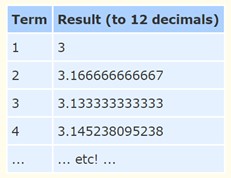
Another quick and easy approximation of Pi commonly used is 22/7 which is 3.1428571, which is not exactly right but is close. Pi is not equal to the ratio of any two numbers, which is why it is irrational. Another ratio that gets us close is 355/113 which comes out to 3.1415929. This is a really good approximation of Pi that is used fairly often. Most commonly and widely, 3.14 is an approximation of Pi when using it in calculations. There are many formulas and ways different people have come up with to approximate Pi. A popular one is called the Nilakantha Series. It is named after an Indian mathematician who lived from 1444 to 1544. The series goes on forever and has the following pattern.

We notice the pattern of numbers in the denominator, and the pattern of alternating addition and subtraction, and keeps following this pattern forever to get us a close approximation of Pi. When we carry out this pattern it gives us the following results.

This is just one of many formulas that we can use to derive the approximation of Pi. You can go to this link to see a whole example of many more ways to calculate Pi.